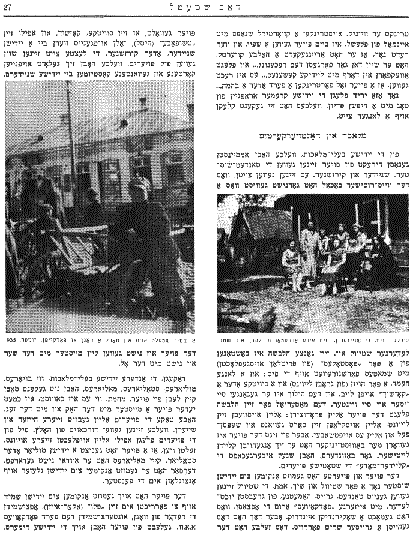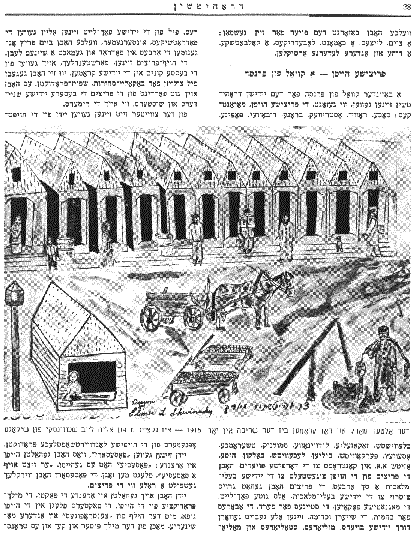Previous Page
|
Next Page
 [
Page 27
]
[
Page 27
]
It was easy for them to drink
down a bottle of whisky all at once. By the time a peasant drank half a bottle,
he had already forgotten how much it cost him, and often returned home to the
village with empty pockets, after having drunk the value of a horse or other
animal.
The Jews storekeepers were able
to earn a substantial living during such trade fairs, and have enough money for
an extended period.
Craftsmen and Artisans
[Photo: Sirka Baum, the seamstress, with her workers at her home]
The Jewish artisans who had the least direct benefit from the peasants were the
second-hand shoemakers, tailors and furriers. There were times when a White
Russian didn't even know about leather boots. Instead, they wore a pair of
Postolas
that were made out of braided
pritlach
with rags around their feet; they also wore a long shirt, a pair of pants
(from coarse linen) and a short sweater or goat vest. They dressed that way in
winter and summer, and they made their own material for their clothes. They
also produced their own linen, cloth and sheep hides. However, when the
peasants became more cultivated, they started wearing higher quality clothing.
The urban peasants particularly took on the fashions of the times.
The peasant men and women would go to the Jewish shoemaker for a pair of boots
and shoes. The truth is that the boots were of cheap quality, large and stiff,
made from the coarsest hide leather, with iron bottoms on the heals, which made
a strong impression. It was still major progress. The peasants really wanted a
Jewish tailor or furrier to make his sweater, goatskin vest and hat. In later
years, there were many peasants who still wanted to have a Jewish tailor make
his clothes. The peasant was no expert in either awls or shears.
[Photo:] A blacksmith sets up his wagon to sell merchandise in the market,
summer, 1935.
On the other hand, the other Jewish artisans, such as builders, painters,
carpenters and bricklayers couldn't make a livelihood from the peasants, since
everyone knew that peasants were experts with axes and saws. The peasants built
their own houses and barns out of wood. Many of the peasants even built their
own ovens. It was very rare for a peasant to use a Jewish bricklayer or
carpenter, and he certainly didn't need a painter. However, the peasants did
make use of Jewish glaziers to build their windows.
The peasants also had to make use of Jewish blacksmiths to repair their plows
or wagon wheels, put shoes on their horses, etc. The Jewish saddlers also made
a living from the peasants,
 [
Page 28
]
[
Page 28
]
who took care of the peasant's needs for bridles, reins, saddles, calfskins and
other leather articles.
[Photo:] Drohitchin market, drawn by Elmer Shevinsky.
The old market and wagon wheel stores before the 1915 fire. Drawn by Eliyahu
Leib Shevinsky of Chicago.
The Landowner's Estate: A
source of livelihood
A different source of livelihood for Drohitchin Jews was, as mentioned before,
the on landowners' estates and manors, such as: Sokha, Roven, Astroveck,
Dubovy, Poppina, Khlevishtch, Zakazelia, Liedviana, Smolnick, Cheromkha,
Osevitz, Perkovitch, Bilien, Lekhevitch, Balkon, Hutta, Ozitch, etc. In
contrast to the village peasants, the landowners provided the Jewish artisans
with quite a bit of work. The landowners trusted the Jewish artisans a great
deal, and considered them good workers. The magnates' apartments and animal
barns and sheds were all built by Jewish builders, bricklayers, carpenters and
painters. Many Jews were even employed as breeders and contractors, and earned
a good living by working for the landowners.
The landowner estates were
obviously the best customers of Jewish storekeepers, who supplied groceries and
food products. The better Jewish tailors and shoemakers also made a good living
from the landowners, as did the saddlers. There were also Jews involved in the
agricultural activities of the estates. There were Jews who were tenants who
managed the estates. These managers were called
possessors
and played a role as important as the landowners themselves.
Jews also leased milk
production on the estates, and would produce milk products such as butter and
cheese at the estate, with the aid of centrifuges and other machinery, and would
Previous Page
|
Next Page
This material is made available by JewishGen, Inc.
and the Yizkor Book Project for the purpose of
fulfilling our
mission of disseminating information about the Holocaust and
destroyed Jewish communities.
This material may not be copied,
sold or bartered without JewishGen, Inc.'s permission. Rights may be
reserved by the copyright holder.
JewishGen, Inc. makes no representations regarding the accuracy of
the translation. The reader may wish to refer to the original material
for verification.
JewishGen is not responsible for inaccuracies or omissions in the original work and cannot rewrite or edit the text to correct inaccuracies and/or omissions.
Our mission is to produce a translation of the original work and we cannot verify the accuracy of statements or alter facts cited.
 Drogichin, Belarus
Drogichin, Belarus
 Yizkor Book Project
Yizkor Book Project
 JewishGen Home Page
JewishGen Home Page
Yizkor Book Director, Lance Ackerfeld
This web page created by Lance Ackerfeld
Copyright © 1999-2025 by JewishGen, Inc.
Updated 3 Dec 2001 by LA
 [
Page 27
]
[
Page 27
]



